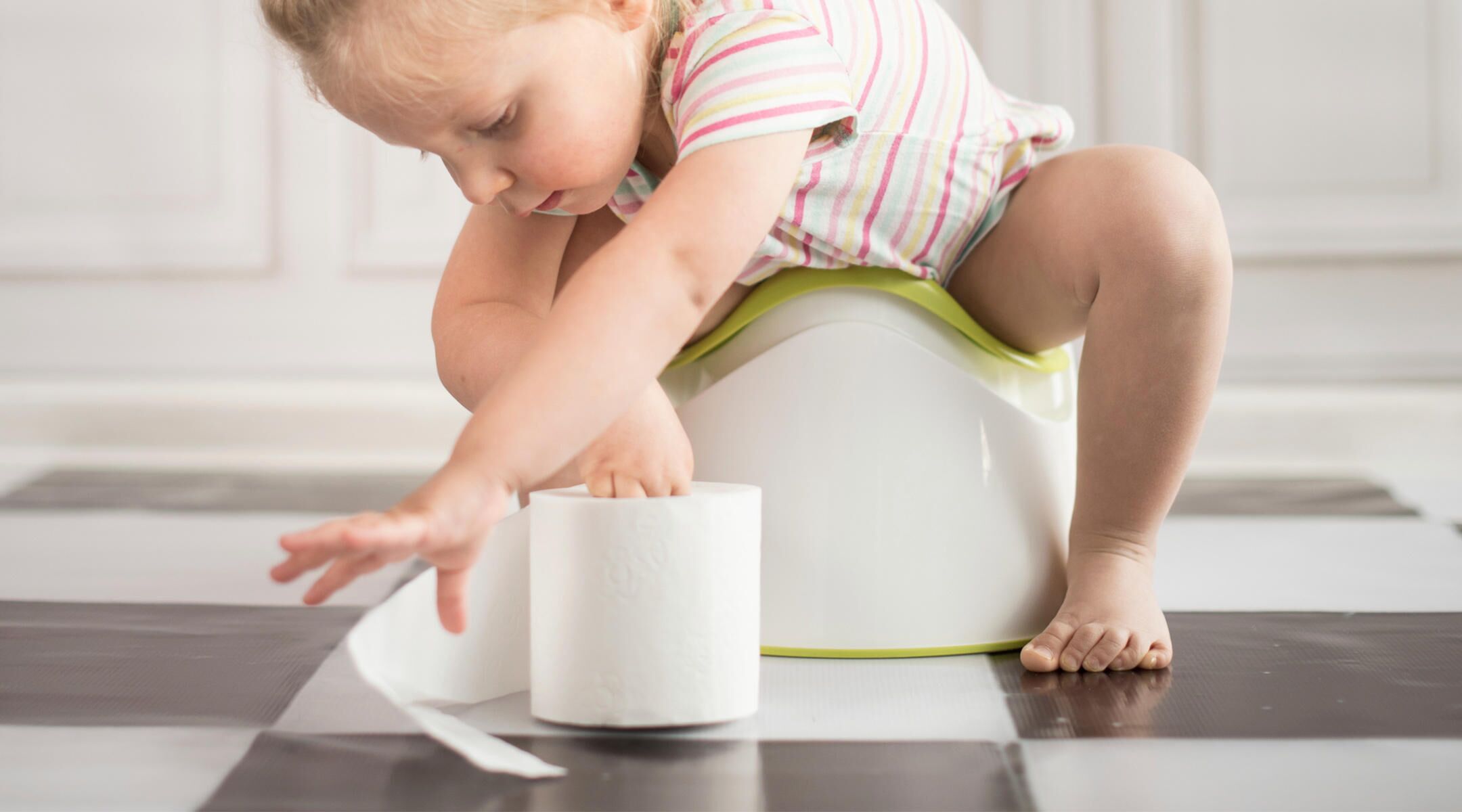Poop Guide for Babies: a Comprehensive Guide to Baby Poop
If there’s one universal parenting truth, it’s that you’re going to be talking about baby poop a lot. (Cue questions: How often should a newborn poop? How can you help baby poop? What does green baby poop mean? What exactly should normal baby poop look like?) And while it may not be a typical topic of conversation for the dinner table, it’s something you’ll find yourself thinking about all the time. Baby’s poop—the color, consistency and amount—can provide important clues into the health of your infant, says Wendy Sue Swanson, MD, a pediatrician and adjunct professor of medicine at Stanford School of Medicine.
Another reason why it’s a perpetual theme throughout the diaper years? Because baby’s poop habits change all the time. In fact, when it comes to baby poop, there’s a whole spectrum of what’s considered the norm. There are a lot of factors that can contribute to color, consistency and frequency. What’s normal for a breastfed baby (i.e. mustard-like poop) may not be normal for a formula-fed baby (soft and yellow, green or brown-ish). A little one who’s eating solid foods will also have baby poop that’s very different from an infant who’s still exclusively breastfeeding or formula-feeding. Suffice to say, baby’s poop will evolve and so will your idea of “normal.”
So what is considered normal baby poop—and when should you be concerned? We’ll help you sort it all out with our comprehensive poop guide for babies. Here’s what to expect from that first diaper change, all the way up through potty training.
Unlike many of your child’s milestones, you likely won’t take a picture of baby’s first poop—but it’s an important one. Usually sticky and darkish green-black in color, baby’s first poop is called meconium and is made up of everything baby ingested in utero, including amniotic fluid, skin cells and water. (Typically, baby should pass their first meconium within 24 to 48 hours of birth.)
Your newborn’s poop should progressively get looser and lighter in color. If it doesn’t, or if baby isn’t consistently pooping in the first few days of life, it could be a sign that they’re not getting proper nutrition and need a follow-up visit with the pediatrician, Swanson says.
In the first four to six weeks of life, regardless of whether your infant is breastfed or formula-fed, you should expect your newborn to poop after nearly every feeding, Swanson says. And depending on whether you’re breastfeeding, formula-feeding or combination feeding, the stools will likely look different. Breastfed baby poop is often yellow, seedy and runny, while a formula-fed baby’s poop may be darker and thicker.
After six weeks, as baby’s digestive tract develops, their poop habits may change. So how often should a newborn poop? It depends. While one to three times or more a day is a benchmark, it’s common for breastfed babies not to poop as frequently as formula-fed babies, especially once they’re at least 6 weeks old.
How often should a breastfed baby poop?
Is your breastfed baby not pooping? Don’t panic as long as they’re gaining weight appropriately. Because breast milk is digested differently than formula, it’s not unusual for a breastfed baby to pee regularly (creating six to eight wet diapers a day) but not poop for several days. “It’s common for a breastfed baby to go two or three days without pooping, and it’s possible for them to go up to seven days,” Swanson says. If your breastfed baby isn’t pooping, it’s more important to watch their demeanor than their diapers. If they seem content and their belly is soft, they’re likely fine. But if their belly feels rigid, baby seems uncomfortable or their poop is hard, it could be a sign they’re constipated, Swanson adds.
How often should a formula-fed baby poop?
Formula-fed babies tend to have poop that’s a bit darker and firmer than breastfed baby poop. Their poop may be the consistency of hummus, toothpaste or peanut butter, and the color can range from yellow to greenish-brown or tan. Formula-fed babies will likely poop at least once a day; if they don’t poop for two or more days, it could signal constipation. Equally important is the consistency of baby’s poop. “Log- or pellet-like shapes could indicate constipation,” Swanson says. It’s important to address this with your pediatrician, since constipation could mean an allergy or be a sign that it’s time to try another brand of baby formula.
When it comes to assessing potential health issues, a pediatrician often checks baby’s poop color. Before you panic, remember that what goes in must come out—especially for babies who are beginning to eat table food. In other words, if baby has beets for lunch, you’re probably going to see red in a few hours. Still, pediatricians agree it’s smart to keep tabs on the colors you see. If you do spot something unusual, bag up the diaper and bring it along to your appointment—it can help a doctor make an assessment.
Baby poop color chart
From green baby poop to red, orange, black and beyond, here’s what each baby poop color could mean:
Green baby poop
With formula-fed infants, it’s normal for baby poop to be a greenish-tan color. Sometimes the iron in baby formula can cause dark green baby poop and isn’t a reason for concern. Green baby poop might also signal teething or that baby is getting over a stomach bug. If baby has green poop and is also fussy at feedings or seems gassy and uncomfortable, it could be a sign they have a cow’s milk allergy and are reacting to the formula, Swanson says, which means you should consult your doctor about other options. For a breastfed baby, green baby poop might signal something else. “Bright green baby poop in a breastfed infant, especially if it’s frothy, may mean they’re getting too much foremilk and not enough of the fattier hindmilk,” Swanson says. Try keeping baby on one breast per feeding or hand-express a bit of milk before letting them latch and see if this solves the problem.
White baby poop
Whether baby’s being breastfed or formula-fed, chalky, whitish or gray baby poop definitely warrants a call to the pediatrician, since it can be a sign the liver isn’t functioning the way it should be.
Orange baby poop
Many of baby’s first solid foods can result in orange-colored baby poop (think: carrots and sweet potatoes). A breastfed baby may also have orange-ish tinted stool if Mom has been on medication or been eating artificially colored foods, since the dyes may make their way into breast milk. Orange poop generally doesn’t indicate a problem, but if you’re worried, call your pediatrician, Swanson says.
Red baby poop
Flecks of red might not be a big deal, but still warrant a call to the pediatrician. If you’re breastfeeding, there might be tiny amounts of blood baby swallowed from cracks in your nipple, and these would show up as maroon or black specks in the baby’s poop. Red flecks might also appear if baby has developed a food allergy or if they’re constipated and straining too hard to poop. If you’re just starting baby on table foods, you may have to play diet detective to suss out any food culprits. Stools that look genuinely bloody or are bright red may indicate an infection, allergy, GI injury or other medical concern and should be addressed immediately.
Black baby poop
If a newborn’s poop is still looking black by day three, it may be a sign they’re not getting adequate nutrition or digesting milk the way they should. If you see black poop when baby’s a bit older, it could be caused by iron in their diet, which is no big deal. If baby isn’t taking an iron supplement and the poop looks black, it could be a sign of GI tract bleeding and should be seen by a doctor. Blood turns from red to black as it travels through baby’s intestines, according to pediatrician Madhavi Kapoor, MD.
Yellow baby poop
Mustard yellow is a normal baby poop color for both breastfed and formula-fed infants. If baby’s stool is bright yellow, the color change could be a result of medications or food eaten by Mom or baby.
Gray baby poop
If baby is eating solids, poop may be gray depending on what your child ate, Swanson says. If baby hasn’t yet started table food, then it’s important to assess, as it could indicate a liver or gallbladder problem.
Before having a baby, you probably never imagined you’d wish for a dirty diaper. But a poop can provide sweet relief for an uncomfortable baby and a worried parent. There are a few common reasons why baby’s not pooping: Dehydration, eating starchy foods like bananas, a time shift due to traveling or occasionally an allergy or intolerance. In older babies, especially those on the cusp of potty training, withholding poop can be psychological—they may be afraid of the potty or upset over an external issue, like a caregiver change or thrown-off schedule.
Luckily, many at-home remedies to help baby poop are simple, effective and recommended by pediatricians—but it’s best to use them only occasionally. “I warn parents not to become dependent on a ‘trick’ to make a baby poop,” Swanson says. “If it’s a persistent problem, it’s something I like to see in the office.”
Here are some ideas on how to get a newborn to poop, as well as what to do when an older baby is not pooping:
- Bicycle legs. Peddling an infant’s legs to and from their chest, as if they’re riding a bicycle, can be a gentle way to stimulate your child’s digestive system, Swanson says. Older babies generally don’t need this trick, since crawling, climbing and pulling up to stand help keep things moving. “This also really worked for us when our son had gas as a newborn,” says Natalie Gontcharova, senior editor at The Bump and mom of one. “A few bicycle legs and he was good!”
- Warm bath. The warmth and stimulation of the water can relax muscles and help baby poop. “This was like a magic trick for all three of my babies. A little midday soak and they were ready to go! Bonus: Once they’d poop, they’d have an extra-good nap!” says Lauren Barth, associate content director at The Bump and mom of three.
- Rectal stimulation. For occasional use only, Swanson suggests gentle rectal stimulation by gently inserting a rectal thermometer or using a gas-relieving product, such as Fridababy’s Windi. However, Swanson cautions this shouldn’t become your go-to trick. “If used too often, the baby may become reliant on rectal stimulation to poop.”
- Baby massage. Baby massage can do wonders, according to Jaclyn Benton, senior account executive at The Knot Worldwide and mom of one. “Our then-1-month-old was really constipated and gassy, and we wanted to stay away from adding medicine and gas drops as much as possible,” she shares. “We tried bicycles, we tried circling her tummy with our palm, we tried keeping her elevated 24/7 and never laying her completely horizontal. Finally, we saw a baby masseuse for craniosacral therapy and it was incredible. She took my baby in her hands, who instantly fell asleep in her arms as she massaged her belly and back. We left with a peaceful baby and had our first blowout on the way home.”
- Water or juice. Constipation can be a sign of dehydration. If baby has started eating solids, offering a few ounces of water or pear juice may help move things along. Constipation may also be a sign baby needs to nurse more or be offered a bottle more regularly. If you’re at all concerned, talk to your pediatrician.
- Glycerin suppositories. Another occasional-use tool, Swanson says glycerin suppositories can be helpful for constipation. Ask your doctor first, especially if baby is younger than a year.
- The four P’s: Prunes, plums, peaches and pears. These four fruits are a great natural way to help baby poop. If baby has started solids, add a serving or two into your child’s daily diet to keep things moving.
- Veggies. The high-fiber content in vegetables makes them all-stars when it comes to dealing with constipation.
- Whole grains. When planning baby’s meals, try incorporating some whole grains: Brown rice, whole-wheat pasta and multigrain cereals or bread. Maximize bran intake, which can help soften stool and make it easier for baby to poop.
Is it normal for baby to grunt while pooping?
If you hear baby making grunting noises, don’t fret. They’re just learning how to have a bowel movement. Infants let out moans and groans as they go; their abdominal muscles aren’t very strong yet, so pooping requires more effort and energy and engages the diaphragm, resulting in some sound effects. It’s not uncommon to see babies straining or making faces while they’re at it too. This is completely normal, and doesn’t necessarily indicate a problem like constipation.
While it’s normal to get a teeny bit less obsessive over every single diaper change as baby grows, it’s still important to keep an eye out for potential problems and warning signs. While some odd consistencies may have a simple explanation (hello, raisins!), others may need to be discussed with your doctor. Here are some types of baby poop to watch out for:
Diarrhea
In infancy, loose stools can be a sign of an allergy, either to the milk proteins in formula or, if you’re breastfeeding, to something you ate. As baby gets older, looser stools may be a sign of teething (baby is swallowing more saliva, leading to runnier poop), but could also be a sign of a stomach bug. In that case, keeping your child hydrated with plenty of water or milk is essential. If the diarrhea is accompanied by a fever of 100.4 degrees Fahrenheit or higher, or baby is younger than 3 months old, it’s a good idea to call your pediatrician, Kapoor says.
Blood in baby stool
While a few flecks might not be anything to worry about, if it’s a frequent occurrence or more than a little, it should be brought to your pediatrician’s attention. “Blood in the stool could be caused by constipation, infection, injury or allergy, so going to the doctor is essential,” Kapoor says.
Mucus in baby stool
A common sign of a cold and maybe of teething, occasional mucus is no big deal. However, “if you notice it frequently or in large amounts, it could be a sign of a GI tract issue and should be discussed with your pediatrician,” Kapoor says.
Stringy baby poop
A cousin to mucus, stringy baby poop could be a sign of a cold or teething, or just the result of something baby has been eating. If it shows up frequently in baby’s diaper, it’s a good idea to call your pediatrician.
Foamy baby poop
“In a breastfed infant, foamy stool may be a sign that baby is getting too much foremilk,” Kapoor says. For an easy solution, try completing a feeding on just one breast. In a formula-fed baby, frothy baby poop could indicate an infection or allergy, especially if accompanied by other symptoms.
Pebble-like stool
This is a classic sign of constipation or withholding stool in older babies. Try some home constipation cures and go to the doctor if baby doesn’t poop within the next 24 hours.
Doctors agree that if you see anything unusual, spot a baby poop problem accompanied by a high fever or if baby is crying inconsolably, you should call the doctor, who can help guide you through possible causes and next steps. And don’t be shy about bagging the diaper for your doctor’s inspection. “We see it all the time, and we aren’t disgusted,” Kapoor says. “It can help us best figure out what the issue may be.”
Yes, you can tell a lot about baby’s health by monitoring the color and consistency of their poop. But if you notice any of the following, you should consult your doctor for advice:
- Breastfed baby hasn’t pooped in over three days
- Formula-fed baby hasn’t pooped in over five days
- Baby poop is hard or or pebbly
- Baby poop is red or black
- Baby poop is white, gray or clay-colored
Frequently Asked Questions
How long can a baby go without pooping?
How long baby can go without pooping depends on baby’s age and whether they’re breastfed or formula-fed, says Lee Beers, MD, a professor of pediatrics and the medical director for community health and advocacy at Children’s National Hospital in Washington, DC. In general, she says, most babies will poop every one or two days. “But sometimes it can be normal to go up to a week without a bowel movement, as long as baby is doing well otherwise and seems comfortable,” she says. “This is especially true for breastfed babies—breast milk is so full of good nutrients that most of it is absorbed for nutrition and less is left over to create poop!”
Why is my baby pooping so much?
“When I hear a baby is pooping too much, I wonder about the consistency of the poop (is it watery?) and hydration of baby,” says Gabrina Dixon, MD, MEd, a pediatrician at Children’s National Hospital in Washington, DC. “Pooping too much may be normal for some babies if baby is gaining weight and well-hydrated, but cause of concern if baby is not gaining weight appropriately, has decreased wet diapers or is dehydrated.” She adds that it can also be an underlying sign that baby has issues with intestinal malabsorption or possibly an infection.
When do babies poop solid?
Baby’s poop typically becomes solid when they start eating solid foods, which for most babies is by 6 months, say Beers and Dixon.
What can I eat to help my breastfed baby poop?
The most important thing that’ll help your breastfed baby poop is for both Mom and baby to stay hydrated, and for Mom to eat lots of healthy foods like fruits and vegetables, say Beers and Dixon.
When does baby poop start to smell?
Although baby poop can smell at any time, you’ll usually begin to notice it more when baby starts solids. “The more solid a stool becomes, and the more new foods are introduced to the diet, the more you’ll start to notice a change in smell,” says Beers.
Do gas drops help baby poop?
Beers and Dixon both say that gas drops aren’t proven effective at helping baby poop. They do help some babies with gas, notes Dixon, but she says it’s best to try non-medical methods like “bicycle legs” first. Adds Beers: “As long as you follow the instructions for dosage, they aren’t likely to be harmful either.”
Does gripe water help baby poop?
There’s no good evidence that gripe water can help baby poop, say Beers and Dixon, and neither of them typically recommend it. Beers adds that if you do choose to use gripe water, be sure to buy one that’s made in the US and alcohol-free.
In the coming days, weeks and months, you’ll likely take up a mission to analyze the contents of your infant’s diaper; checking for normal baby poop is par for the course. The truth is: Everybody poops—and you want to make sure your little one is happy and healthy! To that end, keep our poop guide for babies bookmarked as a reference to help you navigate this sometimes sticky, but always interesting stage of parenthood!
Please note: The Bump and the materials and information it contains are not intended to, and do not constitute, medical or other health advice or diagnosis and should not be used as such. You should always consult with a qualified physician or health professional about your specific circumstances.
Plus, more from The Bump:
Lee Beers, MD, is a professor of pediatrics and the medical director for community health and advocacy at Children’s National Hospital. She earned her medical degree from Emory University School of Medicine.
Gabrina Dixon, MD, MEd, is a pediatric hospitalist at Children’s National Hospital in Washington, DC, and an associate professor of pediatrics at George Washington University School of Medicine and Health Sciences. She earned her medical degree from Howard University College of Medicine.
Madhavi Kapoor, MD, is a pediatrician and a former clinical assistant professor in the department of pediatrics at NYU Langone Medical Center. She received her medical degree from the University of Texas Southwestern Medical School in Dallas.
Wendy Sue Swanson, MD, is a pediatrician, bioethicist and adjunct professor of medicine at Stanford School of Medicine. She directs digital health at Stanford’s Sean Parker Center for Allergy and Asthma Research. She earned her medical degree from University of Pennsylvania School of Medicine in Philadelphia.
Cleveland Clinic, Meconium, September 2022
Learn how we ensure accuracy of our content through our editorial and medical review process.
Navigate forward to interact with the calendar and select a date. Press the question mark key to get the keyboard shortcuts for changing dates.





















































